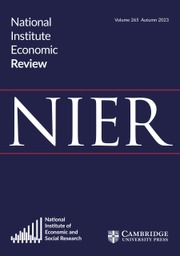No CrossRef data available.
Article contents
Public Sector Borrowing and the Public Sector Balance Sheet
Published online by Cambridge University Press: 26 March 2020
Extract
In his Budget Statement this year the Chancellor restated his medium-term financial strategy (MTFS) and in particular his objectives for the public sector borrowing requirement (PSBR). He said, ‘Since its inception in 1980 the MTFS has indicated a steadily declining path for the PSBR expressed as a percentage of GDP. We have now reached what I judge to be its appropriate destination: a PSBR of 1 per cent of GDP. My aim will be to keep it there over the years ahead. This note considers the implications of that scale of borrowing for the balance sheet position of the public sector. We are able to do this with more confidence thanks to recent publication by the CSO of new figures for the balance sheet positions of all sectors of the economy up to the end of 1985. Prior to that publication, the latest figures available for the overall balance sheet position of the public sector had referred to 1975. The new data modify the picture of recent trends, without changing their character fundamentally.
- Type
- Articles
- Information
- Copyright
- Copyright © 1987 National Institute of Economic and Social Research
References
Notes
(1) Budget Statement by the Chancellor of the Exchequer, 17 March 1987.
(2) Bryant, C.G.E., ‘National and sector balance sheets, 1957-1985’, Economic Trends, May 1987.
(3) Pettigrew C.W., ‘National and sector balance sheets for the UK’, Economic Trends, November 1980.
(4) See Briton, A.J.C., ‘Taxpayers’ capital: the public sector balance sheet', Fiscal Studies, May 1987, which is based on Pettigrew's estimates updated from various sources.
(5) Bank of England Quarterly Bulletin, March 1986, p.76.
(6) Financial Statement and Budget Report, 1987/88, p.9.
(7) For discussion of these and related considerations see the following:
Ashworth, M.H., Hills, J. and Morris, C.N. (1984), Public Finances in Perspective, Institute of Fiscal Studies.
Choraqui, J.C., Jones, B. and Montador R.B., (1986), ‘Public debt in a medium term perspective’, OECD Economic Studies, Autumn.
Odling-Smee, J., and Riley, C. (1985), ‘Approaches to the PSBR’, National Institute Economic Review, no.113, August 1985.


